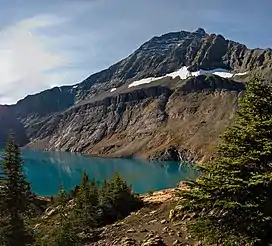| Park Mountain | |
|---|---|
 Park Mountain and Lake McArthur | |
| Highest point | |
| Elevation | 2,951 m (9,682 ft)[1] |
| Prominence | 338 m (1,109 ft)[1] |
| Parent peak | Mount Biddle (3,320 m)[1] |
| Listing | Mountains of British Columbia |
| Coordinates | 51°19′37″N 116°21′06″W / 51.32694°N 116.35167°W[2] |
| Geography | |
 Park Mountain Location of Park Mountain in British Columbia  Park Mountain Park Mountain (Canada) | |
| Location | British Columbia, Canada |
| District | Kootenay Land District |
| Parent range | Bow Range Canadian Rockies |
| Topo map | NTS 82N8 Lake Louise[2][3] |
| Geology | |
| Age of rock | Cambrian |
| Type of rock | sedimentary rock |
| Climbing | |
| First ascent | 1904 Survey Party |
| Easiest route | Scramble class 3 |
Park Mountain is a 2,951-metre (9,682-foot) mountain summit located above the southwest shore of Lake McArthur in Yoho National Park, in the Bow Range of the Canadian Rockies of British Columbia, Canada. Its nearest higher peak is Mount Biddle, 3.0 km (1.9 mi) to the east.[1] Park Mountain is situated four kilometres west of the Continental Divide, and 12 km (7.5 mi) southeast of Field, British Columbia.
History
The mountain was named in 1915 because of the "park-like" setting of the area.[4] The Lake O'Hara area that the mountain is located in is a gem within a park, the best that the Canadian Rockies has to offer.
_BHL48165248.jpg.webp)
The first ascent of the mountain was made in 1904 by a survey party.[1]
The mountain's toponym was officially adopted in 1952 when approved by the Geographical Names Board of Canada.[2]
Geology
Park Mountain is composed of sedimentary rock laid down during the Precambrian to Jurassic periods.[5] Formed in shallow seas, this sedimentary rock was pushed east and over the top of younger rock during the Laramide orogeny.[6]
Climate
Based on the Köppen climate classification, Park Mountain is located in a subarctic climate zone with cold, snowy winters, and mild summers.[7] Winter temperatures can drop below −20 °C with wind chill factors below −30 °C. Precipitation runoff from Park Mountain drains into tributaries of the Kicking Horse River which is a tributary of the Columbia River.
References
- 1 2 3 4 5 "Park Mountain". Bivouac.com. Retrieved 2018-12-11.
- 1 2 3 "Park Mountain". Geographical Names Data Base. Natural Resources Canada. Retrieved 2018-12-11.
- ↑ "NTS Map 82N08 Lake Louise". mec.ca. Retrieved 2019-09-23.
- ↑ "Park Mountain". cdnrockiesdatabases.ca. Retrieved 2019-09-23.
- ↑ Belyea, Helen R. (1960). The Story of the Mountains in Banff National Park (PDF). parkscanadahistory.com (Report). Ottawa: Geological Survey of Canada. Archived (PDF) from the original on 2015-10-02. Retrieved 2019-09-13.
- ↑ Gadd, Ben (2008). Geology of the Rocky Mountains and Columbias.
- ↑ Peel, M. C.; Finlayson, B. L.; McMahon, T. A. (2007). "Updated world map of the Köppen−Geiger climate classification". Hydrol. Earth Syst. Sci. 11: 1633–1644. ISSN 1027-5606.
See also
External links
- Parks Canada web site: Yoho National Park
- Park Mountain and Odaray Mountain panoramic photo: Flickr
- "Park Mountain". BC Geographical Names.